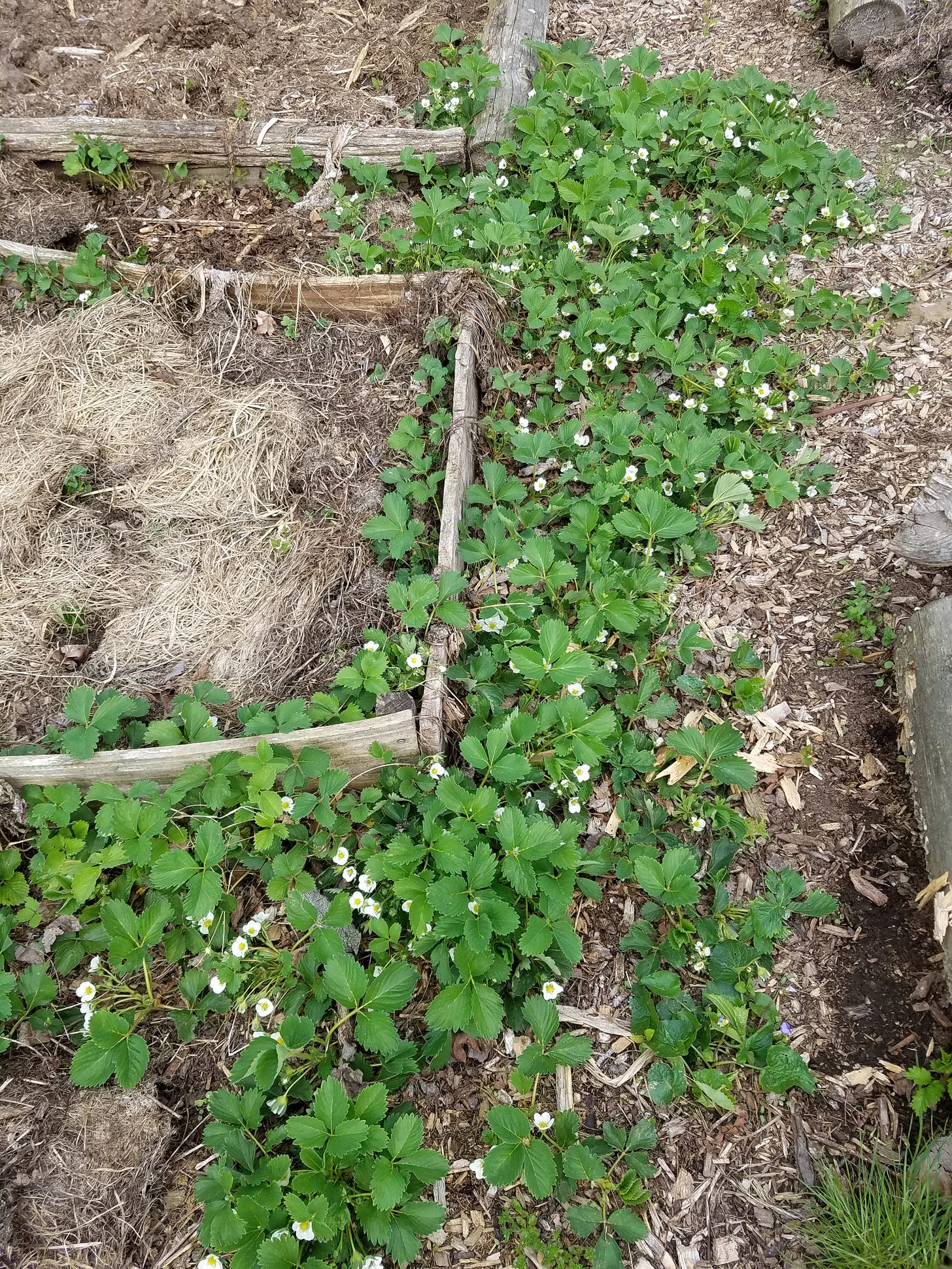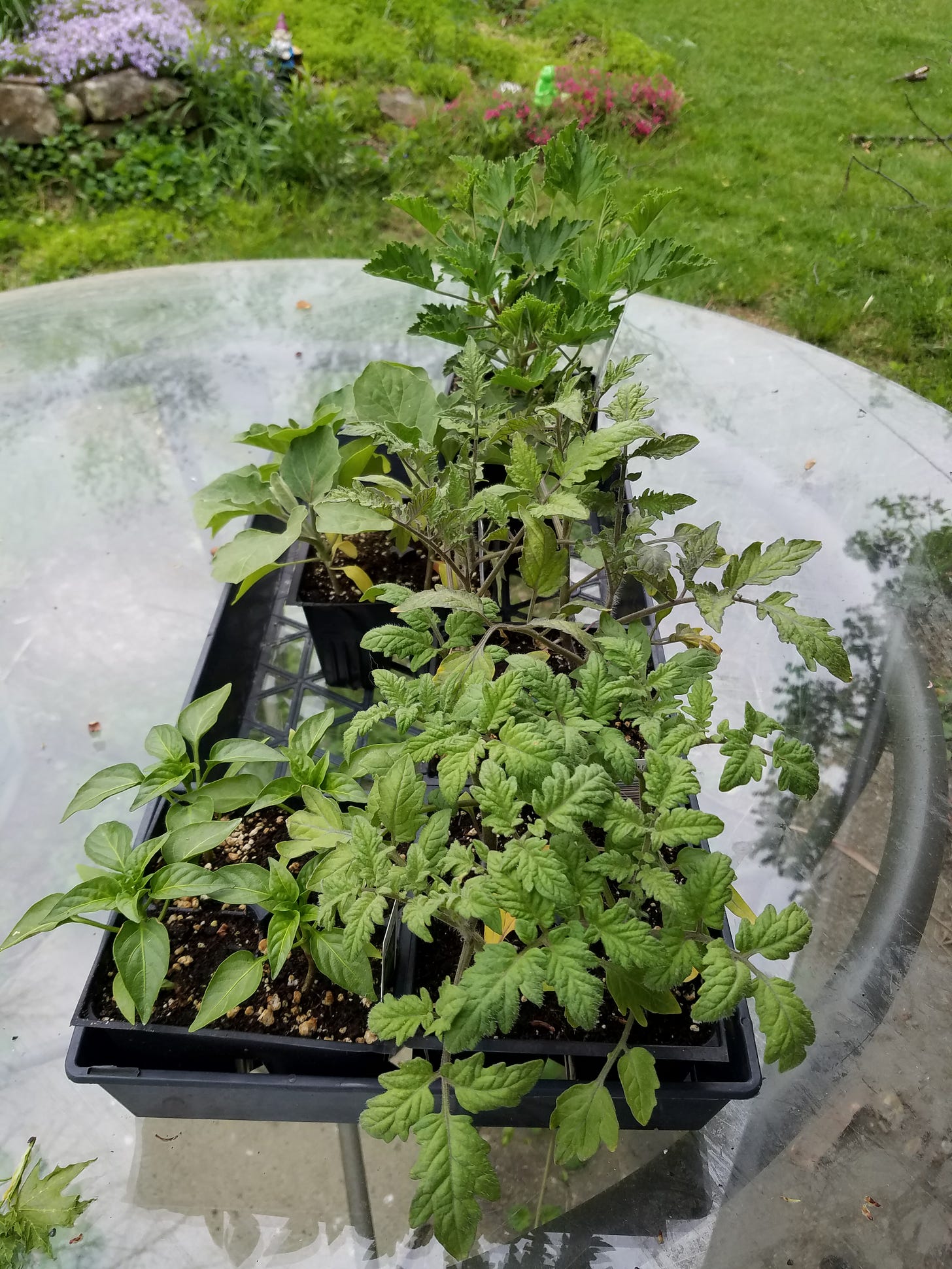Finally some practical gardening tips
Nuts and bolts advice for growing plants for food, medicine, and beauty
Plant strawberries
Strawberries are ridiculously easy to grow because they behave like weeds. In fact it is said that the worst weed of the strawberry patch is the strawberry plant. Buy only a few starts or better yet get some from a gardener who has a mature patch, and by next year you'll have as many as you could ever want.
Strawberries produce well until they become overcrowded, which in my garden only takes a season. They propagate by sending out runners with baby plants on the ends, which root themselves. Cutting these daughters off will keep your evenly spaced plants from becoming a tangled mass, but I can never keep up, and end up with strawberry plants everywhere. Each fall I use some of these new plants to start a brand new bed, which strawberries appreciate because they love moving onto fresh ground. I either rip out the majority of the old bed to make space, or smother it with cardboard and mulch to transition it completely to some other crop. This method is less work than painstakingly removing runners, and I always have strawberries. I let the plants that have migrated into paths stay for a while since they make a weed-suppressing groundcover between beds and provide supplemental berries.
Plant perennial herbs
Herbs practically grow themselves and often prefer poor soil. They spread nicely, and as long as you don't include aggressive mints, they will fill in a bed with little work and expense while behaving themselves. Thyme and oregano stay relatively low are are perfect for bed edges. Slighty taller chives, garlic chives, and sage have attractive flowers as well as culinary uses.
If you're interested in herbal remedies try yarrow and tansy which also have lovely blooms, though the latter can be pretty aggressive in its growth. Anise hyssop, lovage, and valerian are taller selections for the center of the bed, and are best if you have lots of space you wish to fill. Anise hyssop, Agastache foeniculum, (not to be confused with Hyssop officinalis, another great herb) wins the prize for attracting more insects than any other plant in the garden. It's also beautiful and has an extremely long bloom period.
Grow store-bought plants
Starting your own plants indoors from seed can save you money in the long run, but you'll have an initial outlay for lights and perhaps shelving. Plus you'll need space, time, and patience. I lack these things, so I buy starts from a nursery. The process of growing plants from seeds can constitute a large portion of the work of gardening, because the seedlings need lots of attention. I buy healthy and established plants, plonk them in the beds, and water them in. Most of the work was done the previous fall when I prepared the beds by adding compost and topping with a layer of mulch to suppress weeds. With many greenhouses now offering a wide range of veggie plants from heirlooms to famous hybrids, it makes sense to let them do the work. Avoid big box stores, and seek out a small, local garden center to support, and you'll have no reason to feel guilty for out-sourcing this task.
Don't worry too much about companion planting
Grouping plants in specific ways for mutual benefit is a great idea, but the search for magical plant combinations can lead to confusion and paralysis. Allelopathy is real, but the vast majority of veggie, herb, and ornamental annuals and perennials will do fine together chemically. (Fennel and lemon grass are the only ones I've personally observed to have definite adverse effects on their neighbors.) If you’re a beginner and have languishing plants, focus on the basics. It's far more likely that poor soil or improper watering is causing problems rather that bad plant combos. Delve into companion planting once you've got the fundamentals down pat.
For now, rather than combing the internet for the perfect matches, think about plants’ needs and growth patterns. For instance, plant lettuce and spinach in a spot where they will be shaded by the growth of taller sun lovers when the heat comes on. Tomatoes grow tall and are usually staked and pruned, opening up space underneath for basil, carrots, or nasturtiums. My eggplant and cabbages are the most susceptible to pests, so they're adjacent for ease of covering with row covers.
One very important aspect of companion planting that is rarely discussed is grouping plants together by aggressiveness. Gardeners often complain that certain plants are invasive in their gardens, but aggressive or rampant are more accurate terms. Usually the plants in question are mints like monarda, lemon balm, or peppermint—in my garden it's rue and garlic chives. The solution to growing aggressive plants that are desirable for culinary or medicinal purposes is to group them together and let them fight it out. Choose a marginal spot where it's difficult to grow other plants. Bonus points if you plant mints in an area that you mow around to maintain, because you'll get a noseful of delightful scents every time you pass by and cut a few stems. As always, don't be afraid to experiment. My honeyberry-yucca-sage combo wasn’t planned, but it appears to be working well.
Treasure volunteers (or don't)
Volunteers are plants that appear in the garden, unplanned and unplanted by humans. In my garden they include tomato seedlings in compost piles, oak trees from squirrel-forgotten acorns, and potatoes sprouts from those missed in the previous season's harvest. These plants are often bigger and healthier than the ones you’ve nurtured from seeds, and you can leave them be, transplant to a better location, or pull them out for composting, depending on the situation. (Squash volunteers should probably be removed because they will take over and turn out to be gourds.) Volunteers are a gift from the garden and whatever you decide to do with them is fine since you have no time or effort invested in them. Can't beat that.








